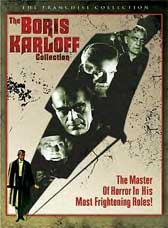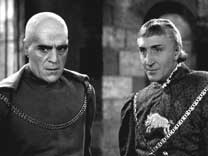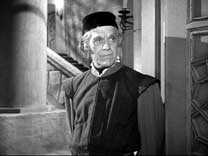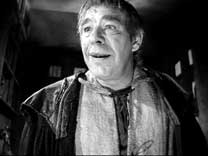 THE
BORIS KARLOFF COLLECTION (1937-1952)
THE
BORIS KARLOFF COLLECTION (1937-1952)When Universal
released their controversial "Bela Lugosi Collection" last year, diehard
fans of older classic horror were a bit taken aback because it seemed that Boris
Karloff got short-changed in the bargain; for while Bela Lugosi was certainly
a major ingredient in that macabre mix, the truth is that the bulk of the movies
in that collection were a dual effort, and they also boasted some of Karloff's
finest work in the genre as well as Bela's. "Why was the last set not entitled
'The Karloff and Lugosi Horror Collection'," we wondered? And, most of
all, ''would Boris Karloff receive equal time with a collection of his own"?

Thankfully, the answer is an enthusiastic "yes"! Universal has now
released five films in "THE BORIS KARLOFF COLLECTION", and it's a
very welcome addition to their steadily increasing repertoire of 1930s, 1940s
and 1950s terror titles. It succeeds competently in filling in a few missing
gaps in the studio's lengthy filmography, but I think it's important to caution
first-timers who may be new to these features that while all these titles are
certainly recommended viewing for all Karloff fans, they're not necessarily
- as the advertising boasts - "Chilling Horror Classics, featuring The
Master of Horror In His Most Frightening Roles!" One of the five movies
is a crime thriller, and a few of the others may more aptly be classified as
costumed melodramas, with some emphasis on horror.
 NIGHT
KEY (1937) is the first and in some ways perhaps the most interesting curio
of the bunch, simply because it is the only title here that has never seen a
home video release of any kind before now. For years it was as good as a lost
film and only remained viewable through spotty and mangled old 16mm prints.
It's a small and harmless crime picture with Karloff simply wonderful as a lovable
old inventor who has developed a complex security system that includes a special
mechanical "key" that is the only means of breaking through. Boris
is ultimately kidnapped by a gang of thugs lead by "The Kid" who try
to force him to help commit robberies by breaking through jewelry stores undetected.
NIGHT
KEY (1937) is the first and in some ways perhaps the most interesting curio
of the bunch, simply because it is the only title here that has never seen a
home video release of any kind before now. For years it was as good as a lost
film and only remained viewable through spotty and mangled old 16mm prints.
It's a small and harmless crime picture with Karloff simply wonderful as a lovable
old inventor who has developed a complex security system that includes a special
mechanical "key" that is the only means of breaking through. Boris
is ultimately kidnapped by a gang of thugs lead by "The Kid" who try
to force him to help commit robberies by breaking through jewelry stores undetected.

TOWER OF LONDON (1939) is a grand historical melodrama which benefits from a
great cast. Richard III (Basil Rathbone) is the unscrupulous would-be king who
double-crosses his own family to seize power with the assistance of his loyal
but murderous executioner, Mord (played by Karloff). Horror legend Vincent Price
has one of his very earliest parts here as the sniveling Duke of Clarence, and
in what may perhaps be the movie's most memorable sequence, is involved in a
battle of wits with Basil Rathbone as the pair indulge in a riveting malmsey
drinking game with a fateful outcome. Though Boris is more a supporting player
in this one, he is magnificent and unrelentingly evil as Mord the Executioner,
and is a consistent presence throughout the film. It's one of his very best
"bad guy" performances. Director Rowland V. Lee also worked with Rathbone,
Karloff (and other players recognizable here in smaller parts) in SON OF FRANKENSTEIN
(also 1939).
 THE
CLIMAX (1944) was directed by George Waggner (THE WOLF MAN). It's noteworthy
as Karloff's first color picture, as he takes on the part of a crazed doctor
made more unstable by a lovely opera singer (Susanna Foster) who resembles a
woman he once loved and who let her singing career stand in the way of their
togetherness. He is now driven by madness once again to silence this successful
new starlet. Though this is a spectacular looking film shot in the dazzling
Technicolor process, unfortunately there's precious little else to admire, and
this seems to be one of those few performances which Karloff just phoned in.
He seems to be on ice throughout, awaiting his paycheck. Turhan Bey (THE MUMMY'S
TOMB) also stars as Ms. Foster's lover, and his best scene just might be the
bit where he nervously eats a concert program while watching the show from the
audience. Unfortunately, Gale Sondergaard is wasted here. Too bad Universal
didn't use their Technicolor approach to better advantage for HOUSE OF FRANKENSTEIN
(also released in 1944 and featuring Karloff) instead.
THE
CLIMAX (1944) was directed by George Waggner (THE WOLF MAN). It's noteworthy
as Karloff's first color picture, as he takes on the part of a crazed doctor
made more unstable by a lovely opera singer (Susanna Foster) who resembles a
woman he once loved and who let her singing career stand in the way of their
togetherness. He is now driven by madness once again to silence this successful
new starlet. Though this is a spectacular looking film shot in the dazzling
Technicolor process, unfortunately there's precious little else to admire, and
this seems to be one of those few performances which Karloff just phoned in.
He seems to be on ice throughout, awaiting his paycheck. Turhan Bey (THE MUMMY'S
TOMB) also stars as Ms. Foster's lover, and his best scene just might be the
bit where he nervously eats a concert program while watching the show from the
audience. Unfortunately, Gale Sondergaard is wasted here. Too bad Universal
didn't use their Technicolor approach to better advantage for HOUSE OF FRANKENSTEIN
(also released in 1944 and featuring Karloff) instead. 
THE STRANGE DOOR (1951) is much more fun. Based on a Stevenson tale, Charles
Laughton is deliciously cruel as a nobleman who cannot forget the jealousy he
felt when his brother married the woman he wanted. Now some twenty years later,
Laughton still keeps his brother imprisoned in the bowels of his castle and
hatches an evil plan to find the most despicable young drunken scoundrel he
can, and then force him to marry his niece (Sally Forrest), who believes her
father is dead. Boris plays a secondary part as a servant to Laughton but who
also maintains loyalty to the imprisoned uncle and vows to foil his master's
evil plan.
 THE
BLACK CASTLE (1952) is an atmospheric and underrated melodrama, though Karloff
is relegated to a rather small part. A young adventurer (Richard Greene) believes
his friends may have been murdered while being guests of the evil Count von
Bruno (Stephen McNally). Traveling to the count's ancient castle under the secret
identity of Richard Beckett as to not arouse suspicion, Greene tries to unravel
clues and divert attention from himself, as von Bruno and he are former enemies
who have not met face to face. When Beckett falls in love with the count's wife
(Paula Corday), they are aided by Karloff, who plays a kindly castle physician
who is also a captive of Count von Bruno. Added to the mix are all the classic
gothic trappings including a crocodile pit, conniving henchmen (played by Michael
Pate and John Hoyt), dungeons, and the horrific element of premature burial.
Lon Chaney Jr. is also featured as a dimwitted brute named Gargon.
THE
BLACK CASTLE (1952) is an atmospheric and underrated melodrama, though Karloff
is relegated to a rather small part. A young adventurer (Richard Greene) believes
his friends may have been murdered while being guests of the evil Count von
Bruno (Stephen McNally). Traveling to the count's ancient castle under the secret
identity of Richard Beckett as to not arouse suspicion, Greene tries to unravel
clues and divert attention from himself, as von Bruno and he are former enemies
who have not met face to face. When Beckett falls in love with the count's wife
(Paula Corday), they are aided by Karloff, who plays a kindly castle physician
who is also a captive of Count von Bruno. Added to the mix are all the classic
gothic trappings including a crocodile pit, conniving henchmen (played by Michael
Pate and John Hoyt), dungeons, and the horrific element of premature burial.
Lon Chaney Jr. is also featured as a dimwitted brute named Gargon.

All five films are presented in their proper and original full frame aspect
ratios at 1.33:1. NIGHT KEY actually utilizes a Realart re-release print and
is remarkably sharp with very few specks or dirt. TOWER OF LONDON struck me
as the least perfect of the set, with occasional scratches or spots noticeable
in occasional scenes, but it's overall still quite sharp and quite acceptable.
THE CLIMAX is beautifully clean and vibrant in its Technicolor presentation.
Both THE STRANGE DOOR and THE BLACK CASTLE are crisp, clean, and reveal practically
no distractions or specks. The mono audio on all titles are clean and clear,
in Dolby Digital 2.0, and optional English and French subtitles are included
for all the films. Two of the films include trailers -- one for THE CLIMAX,
and another for NIGHT KEY (the latter is especially appreciated). Gratefully,
Universal has returned to using DVD-9 technology for this release instead of
the faulty old DVD-18's which reportedly fouled up some of their previous BELA
LUGOSI COLLECTION and HAMMER HORRORS SERIES discs.
Much thanks to Universal for once again digging into their vaults (extra deep
in the case of NIGHT KEY) and offering commercial DVDs of old films to their
fans. THE BORIS KARLOFF COLLECTION and the newly-released INNER SANCTUM MYSTERIES
are hopefully only the beginning, as there are still more old Universal-owned
Horrors with hungry fans awaiting their proper release: ISLAND OF LOST SOULS,
SECRET OF THE BLUE ROOM, MURDERS IN THE ZOO, MYSTERY OF EDWIN DROOD, HORROR
ISLAND, THE MAD DOCTOR OF MARKET STREET, MAN MADE MONSTER, CAPTIVE WILD WOMAN,
NIGHT MONSTER, THE MAD GHOUL.... and onward! (Joe
Karlosi)